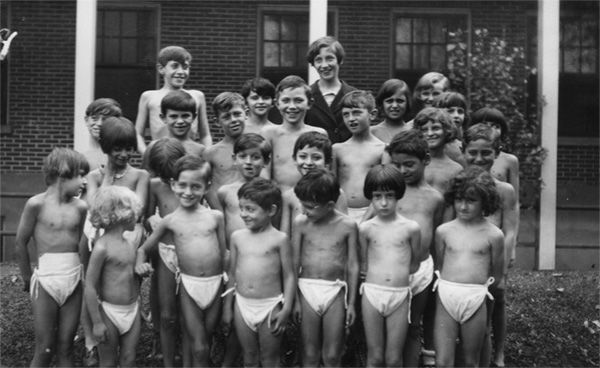Lecture will trace Camp Fee Fee’s history preventing TB in kids
Published February 15, 2017
Tuberculosis was a rampant and deadly disease that knew no boundaries or class distinctions from the late 19th century into the early 20th century. TB ranked with cancer and polio as terrifying and deadly maladies, and the Jewish community of St. Louis, along with others across the nation, attempted a variety of preventive actions, including passing ordinances prohibiting spiting on sidewalks and creating sanatoriums for those suffering from consumption and others to prevent TB among children.
Diane Everman, archivist of the St. Louis Jewish Community Archives, has done extensive research into the 10-week St. Louis sleep-away summer camp that was started in 1926 for children at risk of contracting TB. Called Camp Fee Fee, the camp was described as a Preventorium meant to not only provide children with fresh air, exercise and good food, but to subtly teach them about health.
Everman will give a lecture about the Preventorium’s history at the Jewish Federation of St. Louis (see infobox for details). Everman spoke to the Light about the event.
What was the historical background of the Preventorium in St. Louis?
The peak of tuberculosis in the United States was 1900-1945. Progressive Era activists equated TB with poverty, with those who did not have proper nutrition, housing and sanitation.
In 1903, it was accepted that adult TB was the reactivation of an infection acquired during childhood. Thus, slowly came the idea that educating children about health and hygiene and building up their immune systems might slow or stop the reactivation of the disease. In 1903, Dr. Auguste Rollier opened a clinic for children in the Swiss Alps based on the idea that heliotherapy, an ancient idea about the benefits of exposure to sunlight, could prevent TB in infancy/childhood.
In 1908, scientists discovered tuberculin, a byproduct of the tubercle bacilli culture, could prevent TB in infancy/childhood. Those early tests were the precursors of the small, three-prong, shallow skin tests that many of us remember getting when we were younger.
Did the St. Louis Preventorium deal only with cases of TB?
The focus of the camp became somewhat modified through the years. There was still an anti-tubercular focus, but there were other maladies that the Preventorium was hoping to head off, including malnutrition, which was particularly prevalent in the 1930s. This might seem contrary to the original purpose of the camp, but in reality the goal was to build up the immunity of attending children so they could fight off various maladies, diseases and sicknesses. Children accepted at the camp did not have TB of any type. The goal was to help protect them from contracting it.
Were there any adult residents at the facility as well as kids?
No. The Preventorium was specifically for children, but there were adult patients located on a different section of the large 50-acre plot. The Jewish Sanitarium (for adults) existed near the intersection of Fee Fee Road and Old St. Charles Rock Road, north of the Creve Coeur line, in what was then (a municipality called) Anglum. Parents were encouraged to visit their children on Wednesdays and Sundays, although for many that was not only emotionally difficult for children and parents, it was also difficult because it was so far outside the city.
What was a typical day like for the children at the facility? Were they taught classes in the facility itself?
While the press often suggested a rather rigorous daily routine, conversations with those who attended depicted a rather freewheeling program. Most do not remember a strict regimen. But they do remember playing, whether that was riding bicycles, playing on the swings and bars. The children also presented theatrical presentations. They also enjoyed outside visits to the circus or the zoo, where they could wear regular clothes. Reports record teachers and doctors at the camp. But the camp did not hold regular classes in the strict sense of the word.
Under whose auspices did the Preventorium operate?
In St. Louis, the Preventorium/Camp Fee Fee was under the direction of the health agencies of the Jewish Federation, i.e., primarily under the Jewish Hospital.
When and why did the Preventorium wind down and close?
By the 1930s, the idea of a Preventorium was beginning to fall out of favor. This was due in large part to the fact that there was a decline in the number of new TB cases nationwide and, particularly for the scientific community, there was little, if any, evidence that proved such institutions were effective in preventing adult TB. The introduction of streptomycin in the early 1940s was the final blow to the idea of these sun-exposure summer camps for children.
What sort of memories do former residents have of the facility?
Most children who attended Camp Fee Fee remember it fondly as a pleasant experience and a place to play, be with friends and have a good time. Some however, especially those who went at a very young age, SEE BELOW found the separation from their family an experience that caused lifelong psychological problems.
There are no stories of abuse or ill treatment at Camp Fee Fee, but they do exist elsewhere. Although it might sound harsh to take such young children away from their families for up to 10 weeks during the summer, the Progressive Era activists who began the movement did so with the best of intentions. Today, the idea of children going off to summer camp is common, but that was not true then.















